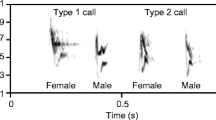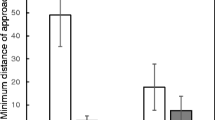Abstract
Much of our knowledge concerning the functions of territorial behaviour and how territories are defended by individuals comes from research on birds. The vast majority of this work has focused on temperate zone breeding territoriality in which territories are defended most obviously by males. Our understanding of the female role in territory defence is limited because they are less conspicuous and much harder to observe. We studied sex roles in territory maintenance and defence in a duetting, resident neotropical passerine, the white-bellied antbird (Myrmeciza longipes). This species maintains territories and pair bonds year round and both sexes sing and actively participate in territory defence. We performed a series of playback experiments throughout the dry (non-breeding) and wet (breeding) seasons. We exposed territorial pairs to three types of stimuli including: (1) single sex, male only songs, (2) single sex, female only songs, and (3) both sex songs/duets. Contrary to findings for most other tropical species, individuals defended their territories with equal levels of aggression regardless of stimuli. Furthermore, sex roles were very different, with males responding more aggressively than females to all stimuli throughout both seasons. Both males and females consistently responded more aggressively to territorial intrusions during the dry season than during the wet season, likely because food abundance is low in the dry season and territory value is high. Our analysis of duetting behaviour suggests that duets do not serve a significant role in mate guarding, or territory defence.




Similar content being viewed by others
References
Amundsen T (2000) Why are female birds ornamented? Trends Ecol Evol 15:149–155
Appleby BM, Yamaguchi N, Johnson PJ, MacDonald DW (1999) Sex-specific territorial responses in tawny owls Strix aluco. Ibis 141:91–99
Balthazart J (1983) Hormonal correlates of behavior. In: Farner DS, King JR, Parkes KC (eds) Avian Biology, vol 7. Academic Press, New York, pp 221–365
Bard SC, Hau M, Wikelski M, Wingfield JC (2002) Vocal distinctiveness and response to conspecific playback in the spotted antbird, a neotropical suboscine. Condor 104:387–394
Brotherton PNM, Rhodes A (1996) Monogamy without biparental care in a dwarf antelope. Proc R Soc Lond B 263:23–29
Brown JL (1964) The evolution of diversity in avian territorial systems. Wilson Bull 76:160–169
Catchpole CK, Slater PJB (1995) Bird song. Cambridge University Press, UK
Clutton-Brock TH, Vincent ACJ (1991) Sexual selection and the potential reproductive rates of males and females. Nature 351:58–60
de Schauensee RM (1966) The species of birds of South America and their distribution. Academy of Natural Sciences of Philadelphia, Philadelphia
Dubois F, Giraldeau L-A (2004) Reduced resource defence in an uncertain world: an experimental test using captive nutmeg manikins. Anim Behav 68:21–25
Emlen ST, Oring LW (1977) Ecology, sexual selection, and the evolution of mating systems. Science 197:215–223
Falls JB (1981) Mapping territories with playback: an accurate census method for songbirds. Stud Avian Biol 6:86–91
Farabaugh SM (1982) The ecological and social significance of duetting. In: Kroodsma DE, Miller EH (eds) Acoustic communication in birds, vol 2. Academic Press, New York, pp 85–124
Fedy BC, Stutchbury BJM (2004) Territory switching and floating in white-bellied antbird (Myrmeciza longipes) a resident tropical passerine in Panama. Auk 121:486–496
Freed LA (1987) The long-term pair bond of tropical house wrens: advantage or constraint? Am Nat 130:507–525
Gill FB (1990) Ornithology. Freeman, New York.
Gill FB, Wolf LL (1975) Economics of feeding territoriality in the golden-winged sunbird. Ecology 56:333–345
Grafe TU, Bitz JH (2004) Functions of duetting in the tropical boubou, Laniarius aethiopicus: territorial defence and mutual mate guarding. Anim Behav 68:193–201
Greenberg R, Gradwohl J (1983) Sexual roles in the dot-winged antwren (Microrphopias quixensis), a tropical forest passerine. Auk 100:919–925
Hall ML (2000) The function of duetting in magpie-larks: conflict, cooperation or commitment? Anim Behav 60:667–677
Hall ML (2004) A review of hypotheses for the functions of avian duetting. Behav Ecol Sociobiol 55:415–430
Hau M, Wikelski M, Soma KK, Wingfield JC (2000) Testosterone and year-round territorial aggression in a tropical bird. Gen Comp Endocr 117:20–33
James FC, McCullough CE (1990) Multivariate analysis in ecology and systematics: panacea or Pandora’s box? Annu Rev Ecol Syst 21:126–166
Karr JR (1971) Structure of avian communities in selected Panama and Illinois habitats. Ecol Monogr 41:207–233
Ketterson ED, Nolan V Jr, Wolf L, Ziegenfus C (1992) Testosterone and avian life histories: effects of experimentally elevated testosterone on behavior and correlates of fitness in the dark-eyed junco (Junco hyemalis). Am Nat 140:980–999
Kroodsma DE (1989) Suggested experimental designs for song playbacks. Anim Behav 37:600–609
Langmore NE (1998) Functions of duet and solo songs of female birds. Trends Ecol Evol 3:136–140
Langmore NE (2002) Vocal duetting: definitions, discoveries and directions. Trends Ecol Evol 17:451–452
Levin RN (1996a) Song behavior and reproductive strategies in a duetting wren, Thryothorus nigricapillus: I. Removal experiments. Anim Behav 52:1093–1106
Levin RN (1996b) Song behavior and reproductive strategies in a duetting wren, Thryothorus nigricapillus: II. Playback experiments. Anim Behav 52:1107–1117
Levings SC, Windsor DM (1982) Seasonal and annual variation in litter arthropod populations. In: Leigh EG, Rand AS, Windsor DM (eds) The ecology of a tropical forest: seasonal rhythms and long-term changes. Smithsonian Institution Press, Washington DC, pp 355–387
McElroy DB, Ritchison G (1996) Effect of mate removal on singing behavior and movement patterns of female northern cardinals. Wilson Bull 108:550–555
McGregor PK (1992) Quantifying responses to playback: one, many, or composite multivariate measures? In: McGregor PK (ed) Playback and studies of animal communication. Plenum, London, pp. 79–96
Mennill DJ, Ratcliffe LM, Boag PT (2002) Female eavesdropping on male song contests in songbirds. Science 296:873
Morton ES, Derrickson KC (1996) Song ranging by the dusky antbird, Cercomacra tyrannina: ranging without song learning. Behav Ecol Sociobiol 39:195–201
Morton ES, Stutchbury BJM (2000) Demography and reproductive success in the dusky antbird, a sedentary tropical passerine. J Field Ornith 71:493–500
Morton ES, Derrickson KC, Stutchbury BJM (2000) Territory switching behavior in a sedentary tropical passerine, the dusky antbird Cercomacra tyrannina. Behav Ecol 11:648–653
Owens IPF, Thompson DBA (1994) Sex differences, sex ratios and sex roles. Proc R Soc Lond B 258:93–99
Ramsay SL, Houston DC (1998) The effect of dietary amino acid composition on egg production in blue tits. Proc R Soc Lond B 265:1401–1405
Roberts SC, Dunbar RIM (2000) Female territoriality and the function of scent-marking in a monogamous antelope (Oreotragus oreotragus). Behav Ecol Sociobiol 47:417–423
Robinson TR, Robinson WD, Edwards EC (2000) Breeding ecology and nest-site selection of song wrens in central Panama. Auk 117:345–354
Stutchbury BJM, Morton ES (2001) Behavioral ecology of tropical birds. Academic Press, San Diego
Walsberg GE (1983) Avian ecological energetics. In: Rarner DS, King JR, Parkes KC (eds) Avian biology vol. 7. Academic Press, London, pp 161–220
Wetmore A (1972) The birds of the Republic of Panama part 3 – Passeriformes: Dendrocolaptidae (Woodcreepers) to Oxyruncidae (Sharpbills). Smithsonian Institution Press, Washington DC
Wickler W (1976) Duetting songs in birds: biological significance of stationary and non-stationary processes. J Theor Biol 61:493–497
Wickler W, Seibt U (1980) Vocal duetting and the pair bond II. Unisono duetting in the African forest weaver, Symplectes bicolour. Z Tierpsychol 59, 217–226.
Wikelski M, Hau M, Robinson WD, Wingfield JC (1999) Seasonal endocrinology of tropical passerines – a comparative approach. In: Adams NJ, Slotow RH (ed) Proceedings of the 22nd International Ornithology Congress, Durban, Johannesberg: Birdlife South Africa, pp 1224–1241
Willis EO (1973) The behavior of oscellated antbirds. Smithson Contrib Zool 144:1–57
Windsor DM (1990) Climate and moisture variability in a tropical forest: Long-term records from Barro Colorado Island, Panama. Smithsonian Contributions to Earth Sciences No. 29
Wingfield JC (1994) Regulation of territorial behavior in the sedentary song sparrow, Melospiza melodia morphna. Horm Behav 28:1–15
Wingfield JC, Hegner RE, Dufty AM Jr, Ball GF (1990) The “challenge hypothesis”: theoretical implications for patterns of testosterone secretion, mating systems, and breeding strategies. Am Nat 136:829–846
Acknowledgements
Earlier versions of the manuscript were improved by valuable comments from Eugene Morton, Laurene Ratcliffe and two anonymous reviewers. We thank the Smithsonian Tropical Research Institute for logistical support in Panama. Rachel Houlihan provided field assistance and Michael Friendly assisted with statistical analysis. We also thank Stan and Pat Rand for providing transportation throughout much of the project. B.C.F. was supported by a Natural Sciences and Engineering Research Council (NSERC) Scholarship and York University Graduate Studies Scholarships. Research was supported by York University Graduate Studies and Sigma Xi grants to B.C.F., NSERC grant to B.J.M.S., and a Smithsonian Scholarly Studies Grant to E.S. Morton. Research was conducted under permits issued by the Autoridad Nacional del Ambiente
Author information
Authors and Affiliations
Corresponding author
Additional information
Communicated by A. Cockburn
Rights and permissions
About this article
Cite this article
Fedy, B.C., Stutchbury, B.J.M. Territory defence in tropical birds: are females as aggressive as males?. Behav Ecol Sociobiol 58, 414–422 (2005). https://doi.org/10.1007/s00265-005-0928-4
Received:
Revised:
Accepted:
Published:
Issue Date:
DOI: https://doi.org/10.1007/s00265-005-0928-4




